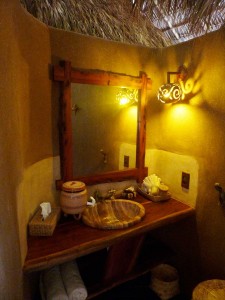Location: Watching a tropical storm from inside a palapa in Playa Viva, just south of Ixtapa, in the state of Guerrero. I marvel at how the woven palm fronds that make up the roof keeps such vast quantities of rainwater out.
Conditions: Cool and windy, with occasional rain squalls. The ocean is a turbulent mess, the landscape swaying with the wind, even the mountains seem to move as the clouds roll around them. By afternoon, the sun burst into view, the wind died down and everything relaxed.
Discussion: I’m not much of a bird-watcher, but the colorful ducks at Yarumi lagoon made me stop.
“This used to be filled with invasive grasses. After we dredged and restored waterflow, the shrimp returned, which attracted the ducks – and many other birds,” Odin Ruz, head of permaculture at Playa Viva, told me. Although it sounds like a restoration project, this is a private hotel. “One of our business goals was to increase biodiversity,” said David Leventhal, the resort’s owner. “We wanted to enhance our guests’ experience besides just doing the right thing.”

Playa Viva has created a micro version of the ideal: a for-profit ecological development. In the hotel industry and mainstream, “eco-design” has come a long way since the days of “Reuse your towels and sheets; save water and save the Earth!” or “Change your lightbulbs to CFLs; it saves you money.” Those are two simple examples of the first rung of the ladder of resource efficiency. We have suffered collective amnesia about that age-old principle, due to the illusion that energy is cheap and resources never-ending (although countries like Japan and Denmark have better memories, or perhaps fewer resources).
The renewed interest in “old-fashioned” practices like passive solar, energy efficiency and good airflow has shown that green design (i.e. resource efficiency) is extremely cost effective. Countless buildings, such as banks in the Netherlands and laboratories in Texas (described in publications such as Natural Capitalism from the Rocky Mountain Institute), show that investment in green construction can be quickly recuperated in electric bills and employee productivity.
One of the reasons that green design has not been adopted as rapidly, despite its obvious benefits, is the “ownership gap”: Developers often sell new buildings to third parties, and landlords are not motivated to reduce their tenants’ bills. In the U.S., this is starting to change with the market recognition of LEED certification and other mechanisms (despite their limitations). More rigorous than green design is sustainable design, which can be defined as an approach that not only minimizes resources but also seeks to generate a zero “net” impact. For example, enough energy and water is produced on site for the building’s use. The newly planned $75 million Oregon Center for Sustainability might become the first large building to embody this model.
The team at Playa Viva wanted to go further — they wanted to actively improve the landscape based on the principles of regenerative design. Hence, they restored Yarumi lagoon and other wetlands to bring them back to life, since palm plantation owners filled them in by the 1930s. Areas overcome by invasive species in the coastal dunes and deciduous forests are being re-colonized with native plant species, with help from Ruz’s permaculture team, to support the plethora of biodiversity that invasives do not.
Why is restoration important and biodiversity loss considered a tragedy?
Skeptics have denounced the effort to save species at the expense of human welfare, as exemplified by the struggle between the endangered spotted owl and the timber industry. However, on a pragmatic level, human welfare is dependent on biodiversity, including all sorts of apparently insignificant creatures such as bacteria, caterpillars and frogs.
The job of pollinating crops and fruit trees, for instance, is done freely by bees and bats (and many others) and the cost of their disappearance would be incalculable. Meanwhile, large predators regulate populations to avoid wild fluctuations. Mangroves, coastal dunes and coral reefs — whose structures are dictated by the interplay of many organisms — all provide a buffer from storm surges, protecting coastal human settlements as well as being a habitat for wild food sources nourishing millions of people. These are examples of what is termed “ecosystem services.”
Beyond the pragmatic level of such “services” to mankind, the diversity of life on Earth is also the source of aesthetic and cultural value to both modern and traditional societies.
Life would be different without medicine (that is mostly derived from plants) and the unexplored mysteries of nature. But aren’t extinctions just a natural process of life? The creation of new species is ongoing, just as extinctions naturally occur. Within the historical record, scientists have noted five great extinction eras, when the collapse of global species accelerated due to meteor strikes and other phenomena. Currently, we are in the world’s sixth great extinction era, the only one caused by a single species — man — and where other species are becoming extinct a thousand times faster than normal.

As Thomas Brooks from Conservation International asked in Hot, Flat, and Crowded, “Imagine what would happen to our lives and planet were any other natural rate to be a thousand times higher today than normal. What would happen if rainfall were a thousand times more than normal? We would be flooded. What if rates of disease transmission of malaria or HIV/AIDS were a thousand times higher? Millions would perish. But that is what is happening to plant and animal biodiversity today.” The planet is being sapped of life at an absurd rate.
Mainstream initiatives are slowly emerging to counter these losses, for example creating protected areas and the Forest Stewardship Council to prevent illegal deforestation.
Reducing damage, however, only buys a little time. Restoring ecosystems is necessary. Although it is just a drop in the bucket, the example of Playa Viva shows how it is possible on a small, manageable scale that everyday people can grasp. Economically speaking, restoration also has many benefits. Modern examples include: residential subdivisions that create artificial wetlands to filter wastewater and toxins to reduce loads on municipal plants; tree replanting in urban areas (such as the work done by Tree People in Los Angeles) that can help control storm water; and mangrove restoration to produce fish-spawning habitat that can supply commercial fisheries.
Biodiversity can also be strengthened indirectly when the other great challenge of modern development is met: resource sustainability.
In Playa Viva, 100 percent of the electricity is produced by a 5.0 kW solar array that shades the parking lot. Since they are off the grid, they are less prone to grid-related failure and aren’t contributing to greenhouse gases and toxic pollution from fossil fuel power plants (or in the case of large hydropower, catastrophic changes to a river’s water regime).
“But we do need to watch our voltage if it rains for three days!” admitted Julia Garcia, the general manager at Playa Viva. They are able to make solar cost-effective through smart planning. Every building is designed for optimum solar orientation and ventilation, allowing them to use fans instead of air conditioners and using low-wattage lighting (which is colored yellow to detract bugs, since the resort is open-air). Hot water for showers is provided by solar water heaters instead of natural gas, and even the fridge/freezer runs on the solar system.
The water-management plan is also robust. Water is drawn from a well and gravity-fed to the resort, which has low-water-flow fixtures (in the bathrooms). Landscaping is carefully balanced between native, drought-tolerant species and aesthetic/food-bearing species placed according to soil type in the property, which are drip irrigated and managed for runoff with techniques like bioswales.

Wastewater from toilets is decomposed in underground anaerobic septic tanks (creating ammonia NH3) then broken up and filtered by constructed wetlands (creating nitrogen, N, and water, H2O) before flowing into a second wetland with lilypads and clean water. The gray water from showers and sinks goes through a lint filter and is used to water the flowerbeds — hence only biodegradable soaps are used. The swimming pool has an AquaPure natural chlorinator that uses electrolysis to convert salt into liquid chlorine, bypassing the need for the toxic chlorine acid typically used in conventional pools.
Overall, the low water use and lack of pollution ensures that local wetlands and waterways remain at their prime — and that humans stay healthy.
“In all projects the most delicate and ever-changing element is human relations,” Ruz said. The implication is that without the support of the community, gains made for biodiversity can be quickly undermined. With this in mind, Playa Viva has several active programs in the community — a recycling program that raises money and keeps trash out of the river; a partnership with a local artisanal salt manufacturer; and support for the local sea turtle nursery, which is 100 percent volunteer-based.
They are striving to leave a positive legacy. For example, workers learning ecological techniques can now apply them to their own agricultural practices. Ruz added: “After helping to build the organic gardens, we noticed people “taking home” the principles of poly-cultivation, soil regeneration, organic pest control and use of plants for medicine. This is information that can expand along the region and leave a social legacy.”
What about the guests at Playa Viva? Do they have more to gain than just a guilt-free vacation? There is no shortage of talk about problems, but real-life solutions that people can see and touch are relatively few. Playa Viva is one example of solutions in practice. Not that it is perfect, as every attempt on the arduous road to innovation inevitably harbors some mistakes, but it inspires through its results.
Green and regenerative technologies are important, but there is another change that is equally needed: a shift in our state of mind. This can be happen after reading an extraordinary book, visiting a national park, or spending enough time in nature. Playa Viva also aspires to do this. As Leventhal expressed it, “One of our goals is to create transformational experiences. That can be as simple as transforming from a busy hectic life to one of observation … or it can be a much deeper transformation. We don’t push, but we provide opportunities for engagement. You select how deep you want to go, and some guests are surprised. Most are.”
Ultimately, it is our mindset that defines how life will be on this planet.





